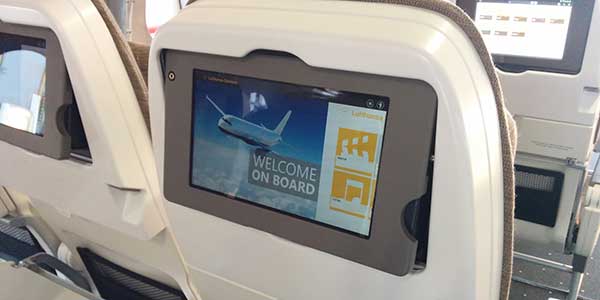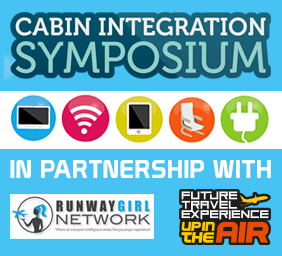
Five years ago, with encouragement from airframers, Panasonic Avionics helped to usher in a sea change in the aircraft interiors industry when it unveiled the first truly integrated IFE/slimline seat in collaboration with Zodiac Aerospace’s Weber unit and design firm Teague.
This so-called Integrated Smart Monitor project was considered groundbreaking in 2009, as it altered how the industry does business. Instead of bolting IFE onto seats as an afterthought, all parties now work together on a standard solution for the cabin before airlines even place their aircraft orders. These integrated IFE/seats are then included in airframers’ catalogues.
Some examples of IFE/seat integration projects can be seen on Delta’s aircraft, where Panasonic’s sleek Eco IFE monitors are integrated into B/E Aerospace’s popular Pinnacle seats; and on Qatar Airways’ Boeing 787s, where B/E and Thales came together to create a visually stunning IFE/seat combination. Dubai-based budget carrier flydubai’s seats represent an integration project between Lumexis’ IFE and seat maker Recaro, and myriad other programmes have rolled out (or are in the process of being rolled out).
“We used to try to crash IFE and the seat together, but we broke that mould with Eco and slim seats – the Integrated Smart Monitor. We continue to do everything we did with Eco; we continue to have a healthy tension between seat makers, OEMs and us when it comes to product development, but at the same time, strategically we’re not complacent and still want to blow the doors off. That’s why we’re especially excited about what we’re doing in economy class,” says Panasonic Avionics Executive Director of Corporate Sales & Product Management Neil James, who will take part in the Cabin Integration Symposium at FTE Global 2014 next week.
Panasonic/Recaro collaboration: ‘A huge opportunity to change the way people travel in economy’
The company will unveil its latest IFE/seat integration project, representing a collaboration with Recaro, during this week’s APEX Expo in Anaheim. “This isn’t a different way to mount something; this is the entire seat-back – the technology, the devices, everything people touch and feel, all integrated seamlessly.
“There are some OEMs that say airlines don’t compete with their economy class products, and other airlines say they see the biggest opportunity in economy class. We’re saying, ‘We see a huge opportunity to change the way people travel in economy class, and give them as much innovation and comfort as humanly possible without changing the space its takes up in the aircraft.’”
Though Panasonic tells us it is once again bringing new technologies to the table with its latest project, the company is working on another concept that will go even further, and “represent a paradigm shift from where we originally started”, says James, stressing that the concept is “pretty groundbreaking stuff”.
Largely veiled in secrecy, the new design was shown to major airline executives during the Aircraft Interiors Expo and the IATA AGM, and the response has been overwhelmingly positive, says James.
Lufthansa Systems’ semi-embedded IFE solution
Other IFE firms share Panasonic’s interest in delivering a better experience to economy class passengers. Lufthansa Systems, for example, is working with a seat manufacturer on an integrated tablet solution that will help catapult the company into the semi-embedded IFE space.
“It is a frame built into a seat which then holds an airline-provided tablet, so we have the possibility of early window movie content on it because it’s an airline owned device. Because it is manufactured in a clever way, we can exchange the monitor much more frequently than with a classical in-seat screen, because you don’t need to change the frame or recertify, in order to plug in a new tablet, and do with every two or three years to keep up with the capabilities on the ground,” says Dr. Jorg Liebe, CIO of Lufthansa Systems, who will also take part in the Cabin Integration Symposium.
Though the company declined to name its partners, attendees at the APEX Expo observed that the seat was built by Recaro.
“What is the solution all about? It’s about getting more flexibility to the airlines. As we all know there are some airlines that really bank on the trend that passengers will simply use their own devices, and there are other airlines that say no, and want to provide them with an in-seat-like solution. The integrated tablet solution is a perfect way to keep the benefits of a personal electronic device solution and still give you an in-seat feeling.
“The content is streaming from the onboard server, but in terms of making it seat-centric, we could still locally store on the tablet. It’s an added feature…and you can update the tablet without modifying the seat.”
It’s clear that the future of IFE/seat integration is bright indeed.
Mary Kirby to lead Cabin Integration Symposium at FTE Global 2014

Mary Kirby, Founder and Editor of Runway Girl Network, will lead the Cabin Integration Symposium at FTE Global 2014, which will take place in Las Vegas from 24-26 September. The Symposium will provide a deep dive exploration into the future of IFEC and aircraft interiors, and a number of the industry’s leading organisations will take part in the Interiors and Connectivity Panels.
As well as Panasonic Avionics’ Neil James and Lufthansa Systems CIO Dr. Jorg Liebe, senior figures from the likes of Airbus, Lumexis, Thales/Live TV, Acro Aircraft Seating, Inmarsat, Honeywell, OnAir, United Airlines, Gogo and Global Eagle Entertainment will also participate.
The Interiors Panel will address both the success and challenges of the latest IFE/seat programmes, and ask what lessons are being learned as industry relationships and products evolve to accommodate new levels of integration (which requires new levels of IP sharing). It will look at how stakeholders are working to try and avoid severe bottlenecks in the interiors/IFE space, and whether ‘complete cabin’ solutions might ultimately prove attractive to airlines, especially as further aircraft production ramp ups are planned.
The Connectivity Panel will then explore what can be done – from an operational, passenger and safety standpoint – when airlines view connected aircraft as a node on their networks. And it will paint a clear picture of what the connectivity linefit/retrofit market looks like so that airlines understand their options now and in the coming years.
» More information on the Cabin Integration Symposium
» Register to attend the Cabin Integration Symposium






